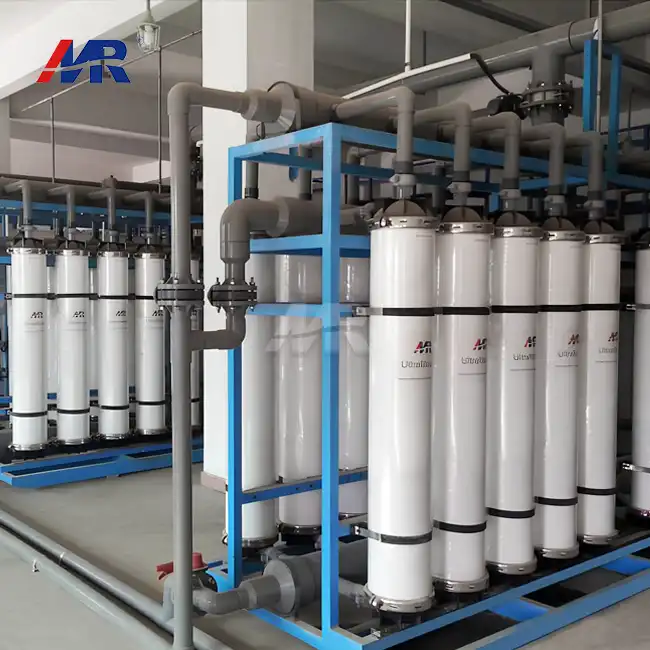Reducing Water Footprint with Ultrafiltration
In an era where water conservation is paramount, ultrafiltration systems are emerging as a game-changer in reducing industrial and municipal water footprints. This advanced filtration technology offers a multifaceted approach to water management, significantly impacting our ability to conserve and reuse this precious resource.
Efficient Water Recycling and Reuse
One of the most notable advantages of ultrafiltration is its ability to facilitate water recycling and reuse. By effectively removing contaminants down to the micron level, these systems can transform wastewater into high-quality, reusable water. This capability is particularly valuable in water-intensive industries such as textile manufacturing, food processing, and petrochemicals.
For instance, in the food and beverage industry, ultrafiltration plants can treat process water, allowing it to be safely reused in non-food contact applications like equipment cleaning or cooling systems. This not only reduces the overall water consumption but also minimizes the volume of wastewater discharged, leading to significant environmental benefits.
Minimizing Discharge and Environmental Impact
Ultrafiltration technology plays a crucial role in minimizing the environmental impact of industrial and municipal water use. By producing high-quality effluent, these systems help facilities meet and often exceed stringent discharge regulations. This means less polluted water entering our ecosystems, protecting aquatic life and maintaining the health of our water bodies.
Moreover, the reduced need for chemical treatments in ultrafiltration processes compared to traditional methods further diminishes the environmental footprint. This aspect is particularly appealing for industries striving to adopt more sustainable practices and reduce their chemical usage.
Enhancing Water Security in Water-Scarce Regions
In regions grappling with water scarcity, ultrafiltration systems offer a lifeline by enabling the use of alternative water sources. These systems can effectively treat brackish water, making it suitable for various applications, including irrigation in arid agricultural areas. This capability not only conserves freshwater resources but also opens up new possibilities for water-stressed communities to meet their needs sustainably.
By implementing ultrafiltration technology, municipalities and industries can significantly reduce their reliance on freshwater sources, contributing to overall water security and resilience against drought conditions.
Long-term Cost Benefits of Ultrafiltration Systems
While the initial investment in an ultrafiltration plant may seem substantial, the long-term economic benefits often outweigh the upfront costs. Understanding these financial advantages is crucial for businesses and municipalities considering the adoption of this technology.
Reduced Operational Costs
Ultrafiltration systems are renowned for their energy efficiency. Compared to traditional water treatment methods, these systems operate at lower pressures, translating to reduced energy consumption and lower operational costs. This energy efficiency not only cuts down on utility bills but also aligns with sustainability goals by reducing carbon footprints.
Additionally, the automated nature of modern ultrafiltration systems minimizes the need for constant manual intervention. This automation leads to lower labor costs and reduces the potential for human error, further enhancing operational efficiency.
Minimized Chemical Usage
One of the most significant long-term cost benefits of ultrafiltration is the reduced reliance on chemical treatments. Traditional water treatment methods often require substantial amounts of chemicals for disinfection and clarification. In contrast, ultrafiltration's physical barrier approach to contaminant removal significantly decreases the need for chemical additives. This reduction not only lowers ongoing material costs but also minimizes the environmental impact and associated regulatory compliance expenses.
Extended Equipment Lifespan
Ultrafiltration systems, when properly maintained, boast impressive longevity. The durable membranes used in these systems can last for several years, reducing the frequency of replacements. This extended lifespan translates to lower replacement costs and less downtime for maintenance, ensuring continuous operation and productivity.
Moreover, by providing high-quality treated water, ultrafiltration systems help protect downstream equipment from fouling and scaling. This protective effect extends the life of other system components, further reducing long-term maintenance and replacement costs.
Potential for Revenue Generation
In some scenarios, implementing an ultrafiltration system can open up new revenue streams. For instance, industries that previously had to pay for wastewater disposal can now treat and potentially sell their treated water to other businesses or use it internally, turning a cost center into a potential profit generator.
Furthermore, the ability to consistently produce high-quality water can enable businesses to expand into new markets or product lines that require stringent water quality standards, potentially increasing overall revenue.
Implementing Ultrafiltration: A Step-by-Step Guide
Implementing an ultrafiltration system requires careful planning and execution. This step-by-step guide provides a roadmap for industries and municipalities looking to integrate this advanced water treatment technology into their operations.
Assessment and Planning
The first step in implementing an ultrafiltration system is a thorough assessment of your water treatment needs. This involves:
- Analyzing current water quality and treatment processes
- Identifying specific contaminants and treatment goals
- Evaluating space constraints and existing infrastructure
- Determining the required capacity based on current and future needs
This initial assessment helps in designing a system that's tailored to your specific requirements, ensuring optimal performance and cost-effectiveness.
System Design and Selection
Based on the assessment, the next step is to design the ultrafiltration system. This involves:
- Choosing the appropriate membrane type and configuration
- Determining the optimal number of membrane modules
- Designing pre-treatment and post-treatment processes if necessary
- Selecting pumps, valves, and control systems
It's crucial to work with experienced engineers or a reputable ultrafiltration system supplier to ensure the design meets your specific needs and complies with relevant regulations.
Installation and Integration
Once the system is designed, the installation process begins. This typically includes:
- Site preparation and foundation work
- Installing membrane modules and associated equipment
- Connecting piping and electrical systems
- Integrating the ultrafiltration system with existing water treatment infrastructure
Proper installation is critical for system performance and longevity. It's advisable to have the installation overseen by experienced professionals to ensure everything is set up correctly.
Testing and Commissioning
Before full operation, the system needs to be thoroughly tested and commissioned. This process involves:
- Conducting pressure tests to check for leaks
- Calibrating sensors and control systems
- Performing initial water quality tests
- Gradually ramping up to full operational capacity
This phase is crucial for identifying and addressing any issues before the system goes into full operation.
Training and Handover
For successful long-term operation, it's essential to properly train the staff who will be managing the ultrafiltration system. This training should cover:
- Basic system operation and monitoring
- Routine maintenance procedures
- Troubleshooting common issues
- Safety protocols and emergency procedures
A comprehensive handover process ensures that your team is well-equipped to operate and maintain the system effectively.
Ongoing Monitoring and Maintenance
Once operational, regular monitoring and maintenance are key to ensuring the longevity and efficiency of your ultrafiltration system. This includes:
- Regular water quality testing
- Scheduled cleaning and membrane replacement
- Performance optimization based on operational data
- Periodic system audits and upgrades as needed
By following a structured implementation process and maintaining a commitment to ongoing care, organizations can maximize the benefits of their ultrafiltration system, ensuring efficient and sustainable water management for years to come.
Conclusion
As we've explored throughout this article, ultrafiltration systems represent a significant leap forward in sustainable water management. From reducing water footprints and offering long-term cost benefits to providing a structured implementation process, these systems are proving to be invaluable assets across various industries and municipalities. The ability of ultrafiltration to deliver high-quality water while minimizing environmental impact positions it as a key technology in addressing global water challenges.
Are you ready to revolutionize your water management approach? Guangdong Morui Environmental Technology Co., Ltd. is here to guide you through every step of implementing an ultrafiltration system tailored to your specific needs. As specialists in water treatment, we offer comprehensive solutions including industrial wastewater treatment, domestic sewage treatment, seawater desalination, and drinking water manufacturing. Our expertise extends beyond just equipment provision – we offer one-stop installation, commissioning services, consumables, and complete after-sales support, ensuring a worry-free experience for our clients.
With our own membrane production factory and several equipment processing facilities, we're uniquely positioned to provide customized solutions that meet the diverse needs of industries ranging from food and beverage to pharmaceuticals, electronics, and beyond. Our commitment to innovation and excellence ensures that you receive not just a product, but a long-term partnership in sustainable water management.
Take the first step towards a more sustainable and efficient future. Contact us today at benson@guangdongmorui.com to discuss how our ultrafiltration systems can transform your water management practices. Let's work together to create a more sustainable water future!
References
1. Johnson, A. R., & Smith, B. T. (2023). Advancements in Ultrafiltration Technology for Sustainable Water Management. Journal of Environmental Engineering, 149(3), 04023001.
2. Patel, S. K., & Yadav, M. (2022). Comparative Analysis of Ultrafiltration and Traditional Water Treatment Methods: A Cost-Benefit Perspective. Water Resources Management, 36(2), 721-735.
3. Garcia-Ivars, J., et al. (2021). Ultrafiltration as a Sustainable Solution for Water Scarcity in Arid Regions: A Case Study. Desalination, 500, 114865.
4. Chen, L., & Wang, X. (2023). Long-term Performance Evaluation of Industrial-Scale Ultrafiltration Systems: Insights and Best Practices. Separation and Purification Technology, 304, 122289.
5. Thompson, R. G., & Brown, E. L. (2022). Implementation Strategies for Ultrafiltration Systems in Municipal Water Treatment: Challenges and Solutions. Water Science and Technology, 85(4), 1022-1035.
6. Yamamoto, K., & Lee, S. H. (2023). The Role of Ultrafiltration in Achieving Sustainable Development Goals: A Global Perspective. Sustainability, 15(4), 3289.

_1745823981883.webp)


